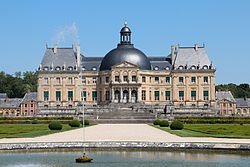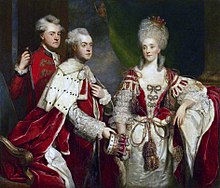
The aristocracy (from Greek ἀριστοκρατία aristokratía, "rule of the best"; Latin: aristocratia) is historically associated with a "hereditary" or a "ruling" social class.[1] In many states, the aristocracy included the upper class with hereditary rank and titles. They are usually below only the monarch of a country or nation in its social hierarchy.[2]
History

In some, such as ancient Greece, ancient Rome, or India, aristocratic status came from belonging to a military class. It has also been common, notably in African and Oriental societies, for aristocrats to belong to priestly dynasties. Aristocratic status can involve feudal or legal privileges.[3]
Plato’s Symposium offers a glimpse into the intellectual and cultural life of aristocracy in ancient Athens. The dialogue takes place at a banquet attended by prominent Athenian aristocrats, illustrating how the elite not only wielded political and military power but also shaped philosophical and artistic discourse. Their discussion on love, centered around Eros, reflects how aristocrats engaged in intellectual refinement and rhetorical debate, reinforcing their status as the cultural and moral leaders of society.[4]
Early modern aristocracy
The ancient world had bequeathed to early modern Europe (notably via Aristotle's Politics) a political and personal definition of aristocracy as the rule of the best men.[5] According to his 1602 political treatise República Mista, Tomás Fernández de Medrano describes an aristocrat as someone who is distinguished by virtue, morality, and wisdom, holding authority over the rest—whether broadly or in specific matters—governing solely for the benefit and welfare of the public.[6]
While family background and wealth could enhance one’s suitability for public office, they were not definitive. Prominent families could produce unworthy heirs, while talented newcomers might possess the qualities necessary for political leadership. This notion of social status clashed with the medieval system, which divided society into three estates and defined aristocrats primarily as warriors, gradually making aristocracy more rigidly tied to noble birth.[5]
Across Europe, the aristocracy wielded immense economic, political, and social influence. In England, a small high aristocracy—about two hundred families—controlled roughly a quarter of the kingdom’s land, while in seventeenth-century Bohemia, an even smaller noble class owned two-thirds of the land. This dominance extended beyond landownership, as aristocrats and gentry often monopolized high-ranking positions in the church, military, and administration. Before the French Revolution, aristocratic privilege was deeply embedded in Europe’s social order, shaping both governance and ideology.[5]
The centralization of royal courts in early modern Europe reshaped aristocratic power, shifting influence from regional noble domains to the monarchy’s court. This transition reflected a broader shift across European aristocracies, where status and influence became increasingly tied to proximity to the sovereign, court patronage, and administrative roles, rather than independent territorial rule.[7]
Modern aristocracy
Despite their decline in the 19th and 20th centuries, aristocrats and gentry remained influential, adapting to modernization as industrialization and democracy eroded traditional claims to privilege. Their response to these changes played a crucial role in shaping the broader transformation of European society.[5]
In modern European societies, the aristocracy has often coincided with the nobility, a specific class that arose in the Middle Ages, but the term "aristocracy" is sometimes also applied to other elites, and is used as a more general term when describing earlier and non-European societies.[8] Aristocracy may be abolished within a country as the result of a revolution against them, such as the French Revolution. Revolutionary leaders, aiming to dismantle hierarchical structures, labeled even non-noble opponents as "aristocrats" in their push for a society without inherited privilege.[5]
Etymology

The term aristocracy derives from the Greek ἀριστοκρατία (aristokratia from ἄριστος (aristos) 'excellent' and κράτος (kratos) 'power').[9] In most cases, aristocratic titles were and are hereditary.
The term aristokratia was first used in Athens with reference to young citizens (the men of the ruling class) who led armies at the front line. Aristokratia roughly translates to "rule of the best born". Due to martial bravery being highly regarded as a virtue in ancient Greece, it was assumed that the armies were being led by "the best". This virtue was called arete (ἀρετή). Etymologically, as the word developed, it also produced a more political term: aristoi (ἄριστοι). The term aristocracy is a compound word stemming from the singular of aristoi, aristos (ἄριστος), and the Greek word for power, kratos (κράτος).
From the ancient Greeks, the term passed to the European Middle Ages for a similar hereditary class of military leaders, often referred to as the nobility. As in Greece, this was a class of privileged men and women whose familial connections to the regional armies allowed them to present themselves as the most "noble" or "best" of society.
See also
- Gentry
- Landed gentry (United Kingdom)
- Landed gentry in China
- Landed gentry in Poland
- Honorifics
- Nobility
- Upper class
- Imtiaz (Egypt)
- Chieftaincy (Nigeria)
- Old money
- Peerage (United Kingdom)
- Royal and noble ranks
- Styles (manner of address)
- Titles
- Social capital
- Symbolic capital
- Honour
- Adel (Norway)
- Yangban (Korea)
- Kuge (Japan)
- Samanta, Thakur, Zamindar and Jenmi (India)
References
- ^ "Definition of Aristocracy". Archived from the original on 2019-03-26. Retrieved 2019-09-18.
- ^ "Definition of ARISTOCRACY". www.merriam-webster.com. November 29, 2024.
- ^ The Aristocrats: a portrait of Britain's nobility and their way of life today, by Roy Perrott, (London 1968), pp. 5–10.
- ^ "Lovers and Soldiers". National Endowment for the Humanities. 2021-06-22. Retrieved 2025-03-16.
- ^ a b c d e "The Aristocracy and Gentry | Encyclopedia.com". www.encyclopedia.com. Retrieved 2025-03-16.
- ^ Medrano, Juan Fernandez de (1602). República Mista (in Spanish). Impr. Real.
- ^ Hernández, Santiago Martínez (2020). "Between Court and Village: The Evolution of Aristocratic Spaces in Early Modern Spain". Renaissance and Reformation / Renaissance et Réforme. 43 (4): 19–54. ISSN 0034-429X.
- ^ "Modern European societies and the nobility of aristocracy".
- ^ The Oxford Companion to British History, John Cannon (editor), Oxford University Press, 1997, ISBN 978-0-19-866176-4








